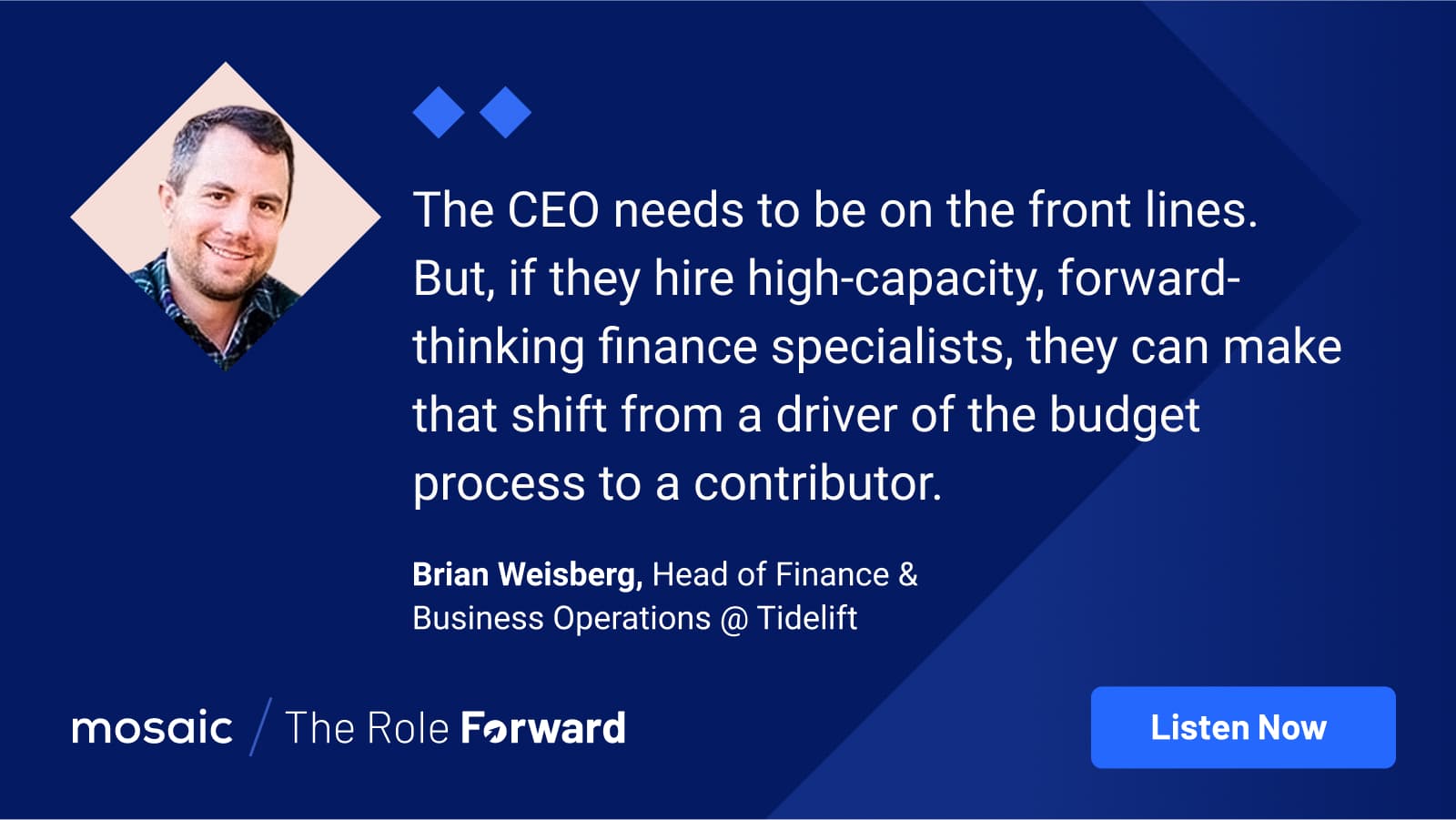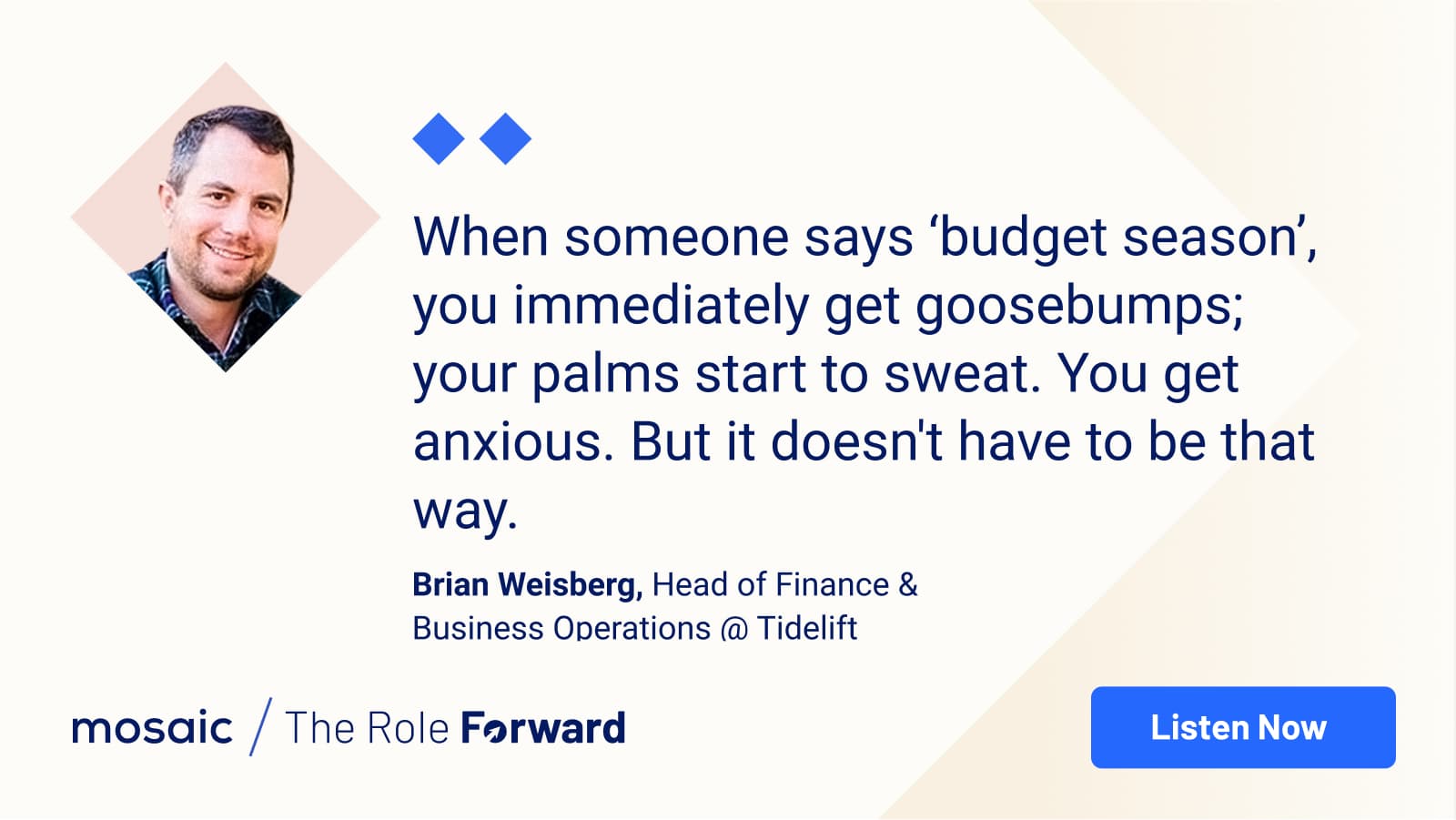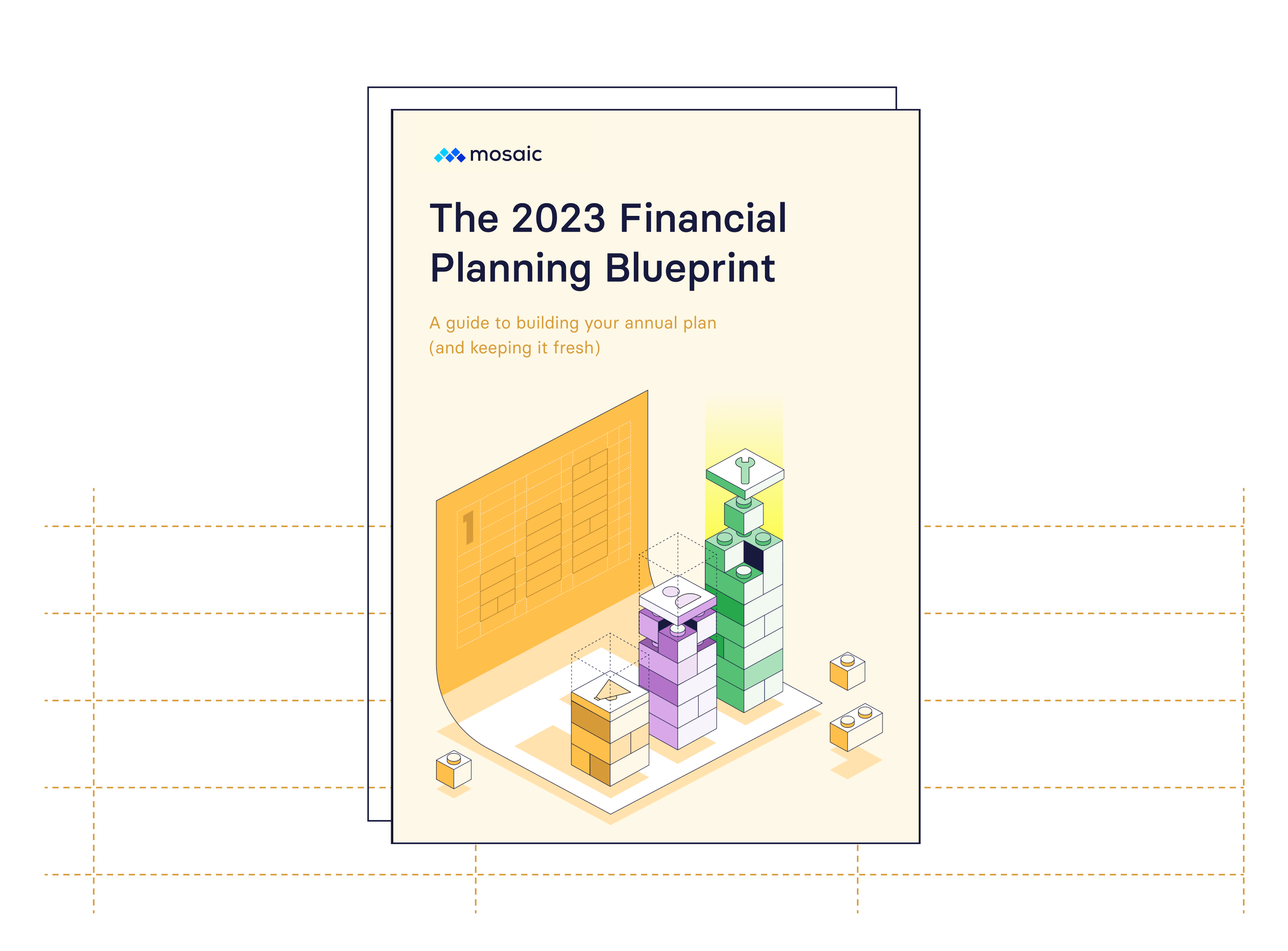Budget planning is like assembling a fishbowl. You’ve got sand, rocks, and different decorative elements and you want to maximize space to fit as much as you can in the bowl.
If you place the sand in first, you only have one layer to assemble the many rocks and decorations. But if you place the decorations first and then assemble the rocks around them, the fine grains of sand easily fill in the gaps.
Brian Weisberg, Head of Finance and Business Operations at Tidelift, used this analogy on an episode of The Role Forward Podcast about budgeting. He said that the decorations serve as the large conversations finance teams need to have to dive into the budgeting process.
But in order to dive in properly, finance teams need to know whether to start with a top-down or bottom-up budgeting approach.
Budgeting can be a daunting task for all involved. Planning from the top down can make individual departments feel as if their voices aren’t being heard. Building from the bottom up can feel like a tedious process that takes away from more practical tasks. There’s no single right approach, whether it’s top-down, bottom-up, or even a flexible budget strategy. You need to find the balance that works best for your organization.
Table of Contents
What Is Top-Down Budgeting?
Top-down budgeting is a type of budget allocation where executive leadership and senior management set high-level budgets based on company objectives. Once approved, management “pushes down” the budget to department heads, who communicate it to their team members.
Top-Down Budgeting Processes Explained
The top-down budgeting approach focuses on historical trends and high-level goals for company growth.
Senior management determines the goals for the forthcoming year. Using the previous year’s budget as a benchmark, they consider how each department utilized their budgets and contributed to revenue. They’ll also consider current market conditions to forecast what budget is necessary to accomplish the company’s objectives.
Once numbers are configured, finance analyzes the data and forecasts the goals against any growth trends and expectations. Revenue remains the largest factor, but growth can be broken into other factors, such as general team growth. For example, if the marketing team doubled to six members, the trend might be to double the team again to keep pace with revenue goals.
While atypical, the top-down process may include management consulting lower-level managers for suggestions toward what they would like to budget for in each department. Once all input has been accounted for, finance revises the budget based on senior management input. Once management reviews and approves, department leaders are informed and can begin allocating their budget as they see fit.
What Is Bottom-Up Budgeting?
Bottom-up budgeting is the opposite of top-down budgeting, where department managers draft plans based on their strategic needs and goals, then present it up to senior management and executive leaders.
This type of strategic budgeting approach is often more time-intensive than top-down budgeting. But the more collaborative approach can improve accuracy and alignment in budget proposals.
Bottom-Up Budgeting Processes Explained
The bottom-up budgeting process starts with each department identifying their goals and plans for tactical projects for the year.
Each department needs to identify their goals — and what it costs to achieve their goals. Marketing, for example, might want to put on five events for the year. They need to outline who the vendors will be, what they will spend for promotion, and determine an estimate for how the event will contribute to revenue.
The sales department has to plot out a path to maximize revenue growth. They’ll build out a sales capacity model that accounts for headcount planning (how many reps to hire and when) and how long the sales rep ramp cycle lasts until the representative gets to full productivity.
Once the department managers outline their goals and spend, they deliver their budgets to finance. Finance aggregates the data into an overall company budget, which finance reviews with executives for final signoff. Once approved, finance allocates resources to each department.
Difference Between Top-Down vs. Bottom-Up Budgeting:
In top-down budgeting, upper management sets budget constraints for departments. In contrast, bottom-up budgeting lets departments formulate their budgets and present them to the upper management for approval. This begs the question, which type of budgeting is right for you?
We discuss some other differences below to help you resolve the top-down vs. bottom-up debate at your company.
Bandwidth for Spend Creativity
A bottom-up budgeting approach may be taxing on departments to figure out.
They’re not finance experts, which is why budgeting processes come with such a painful stigma. Departments want to focus on their areas of expertise, with AEs selling, creatives writing and designing content, and engineers building code. Taking the time to create a detailed budget may distract from their day-to-day work routines.
The top-down budgeting approach centralizes spend to top-tier management. Departments are given a pool of money to spend, which empowers them to focus more on the actual work and be creative (yet practical) with how they spend their budget.
Collaboration and Buy-In
The top-down budgeting approach typically has little-to-no department manager involvement. Again, the C-suite and senior management can ask for suggestions, but they’ll drive the conversation based on what to prioritize in terms of the company’s growth goals.

Buy-in for a top-down budget is already included at the executive level — but it may take time to get departments on board. This approach can lead to misalignment in hiring plans for full-time employees as well as big-picture campaign or product planning.
In bottom-up budgeting, each department manager can conduct meetings with their team members to consider what they foresee for the next fiscal year. Once the department heads have some numbers, they can meet with finance to double-check how the budget compares with last year’s before it’s delivered to senior management for approval. At that point, executive leadership and department heads can collaborate on any revisions.
In terms of buy-in, the bottom-up approach will have departments hopeful and require some convincing leadership to see how the budget aligns with revenue growth and other company objectives. There may be some revisions required to meet growth prioritizations, but overall this approach can often generate greater alignment at all levels of the organization.
Data Influence on Budget
As the top-down budgeting approach focuses on trends and predictions, management typically approaches forecasting next year’s budget with a “use it or lose it” mentality. While departments are given a pool of money, they need to spend it. Management will notice if marketing only spends $350k of its $400k budget. Next year, instead of getting $450k, executive leadership decides to allot $375k.
But not all companies have the kind of infrastructure to extend that same data visibility to individual departments and employees. The bottom-up budgeting process puts more power in the hands of department leads — but it only works if they have insight into all the relevant financial data for their functions.
If they don’t have the right visibility, you risk having a bottom-up approach that’s more based on gut feelings than data-driven insights about what’s working and what isn’t.
The Best Budgeting Approach for Your Company
Whether you’re a startup or planning toward a series D funding round, the best budgeting approach is a mix of top-down and bottom-up budgeting approaches.
For Startups Approaching Series A
Startups should approach the budget process with a top-down philosophy: Determine what your large goals are for a Series A funding round.
While startups don’t have historical data to show potential investors, conducting competitor analysis reveals the growth narratives of others in the market. Senior management can present their estimated growth trajectory by comparing themselves to other competitors, and presenting their budget based on their findings.
It’s not perfect — but when you don’t have any trends to work off of, that top-down approach can give early-stage leaders more control over their plans.
For Mature Companies Approaching Series B and Beyond
More established companies have historical data to reference, which is prime for a bottom-up budgeting approach. The bottom-up budgeting approach shows that the numbers make sense, and can be broken down specifically into vendors, events, software spend, etc., making it predictable to carry over into next year and easier to adjust during the planning process.
However, there’s a point when it’s no longer possible to rely entirely on a bottom-up budgeting approach.
A company with a $100 million budget wouldn’t be as invested with how each functional area spends thousands of dollars — that’s when a top-down approach, where executive buy-in and approval are ingrained, serve a much greater purpose than going incredibly granular in details, like spend per vendor. At that point, finance would bring on specific FP&A employees dedicated to aligning individual department budgets with overarching company goals.
For the Best of Both Worlds, Triangulate and Analyze Scenarios
When Weisberg discussed how to take the pain out of the budgeting process, he presented the idea of triangulating your revenue model to ensure it’s being viewed from multiple angles. He noticed that triangulation made broader budgeting conversations with other department leaders better aligned around business goals.

A top-down budgeting approach focuses on the big picture, while bottom-up budgeting begins with granular spend requests that build toward overall goals. The third point is to consider the pipeline. Your sales pipeline metrics provide trending data (founded in the top-down approach), which you can analyze to consider customer acquisition and ramp timeline to predict growth.
Working through multiple scenario analysis examples allows you to pose different questions that mix budgeting processes together and ensure multiple vantage points are considered. If you were to ask, “How many people would we need to get to $2 million in revenue?” you’re blending an ARR snowball (a top-down approach) with a sales capacity model (bottom-up approach).
Most companies don’t have the bandwidth to manage both approaches to the budgeting process — building one plan is hard enough. But there’s no denying that sense-checking one plan against the other is a more accurate way to budget for the year ahead. Finance just needs an easier way to maintain multiple models.
Your Decision in Top Down vs. Bottom Up Budgeting Made Easier: Build Both with Mosaic
As Weisberg said, being able to triangulate your budgeting approach and encourage collaboration across the entire company is best.
Finance can proactively drive the budget planning process with Mosaic. Our Strategic Finance Platform integrates with your source systems, automating the tedious data collection processes that slow planning down and freeing you up to build top-down and bottom-up budgeting models more easily. You gain multiple vantage points with each approach and can see exactly where and why each approach is different.
Set your sights on solidifying your budgeting approach by downloading our modern financial planning ebook. Or, if you’re ready to dive right into the fishbowl of real-time budget analysis and more efficient budgeting, request a personalized demo of Mosaic’s business budgeting software. We look forward to swimming alongside you toward better budgeting, whatever angle you take.
Give Department Leaders Deep Financial Insights for Better Budgeting

Top Down vs Bottom Up Budgeting FAQs
How can a company ensure an accurate budget?
An accurate budget is achieved by blending both top-down and bottom-up methods, analyzing historical data, current market conditions, and departmental strategic needs. Using tools like Mosaic can further enhance accuracy by integrating with source systems and automating data collection.
What are the risks of over-budgeting?
How does top-down budgeting affect day-to-day operations?
Can I manage my budgeting process in Excel?
What role does the CFO play in the budgeting process?
What are the various kinds of top-down budgeting methods?
Own the of your business.


